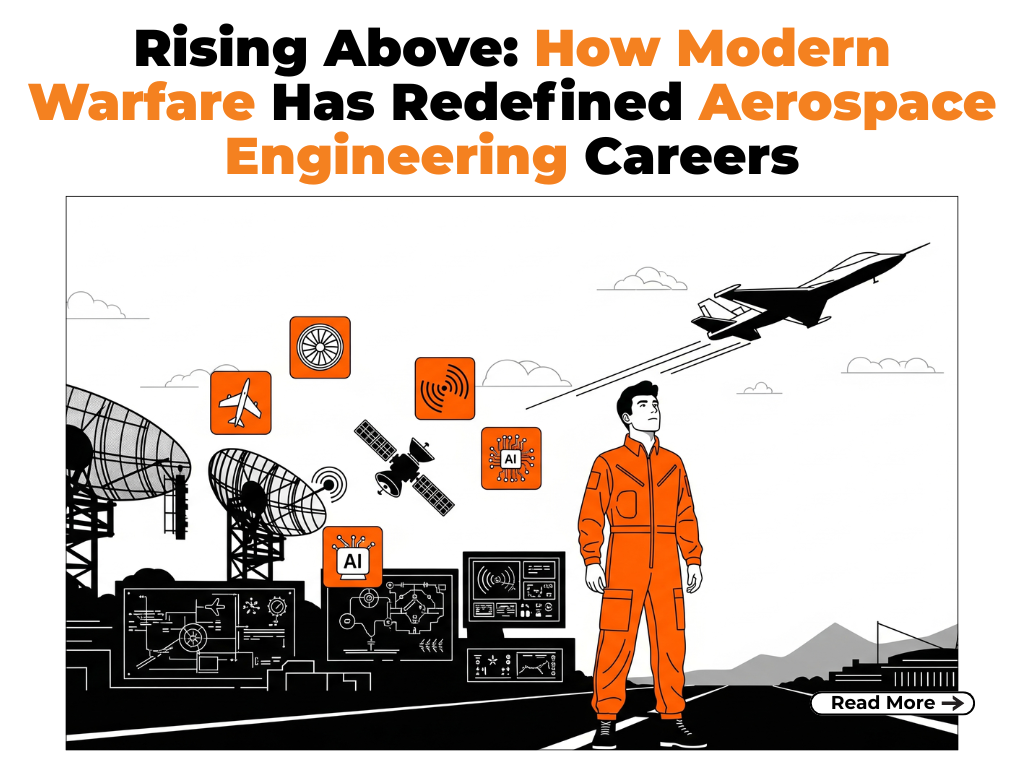A new wave of interest in aerospace engineering careers has been sparked by the evolving nature of modern warfare and aerospace, especially in regions affected by recent conflicts. A new era of innovation, technological urgency, and strategic evolution has been ushered in by the recent military confrontation between India and Pakistan, which has caused a profound transformation in the aerospace and defense industries. What had appeared to be the domain of high-level government organizations and futuristic movies has now become a fundamental reality. This struggle has led to an unrelenting increase in demand for advanced aircraft capabilities, from AI-powered defense systems to autonomous drones.
For young people hoping to pursue careers in aerospace engineering, this is not only a watershed moment, but also an once-in-a-lifetime chance. As defense ministries, private companies, and global startups compete to outsmart threats through technological superiority, the aerospace engineering job market has grown significantly.
- A Post-War Paradigm Shift: The Rise of Next-Gen Aerospace Demands
The India-Pakistan war acted as a wake-up call for several countries, demonstrating the critical significance of unmanned aerial vehicles (UAVs), stealth surveillance systems, and hypersonic weaponry in modern warfare. No longer confined to the skies, aerospace engineering has transcended its traditional boundaries and emerged as a critical pillar of national security.
Noteworthy Technological Outcomes:
- Mass Integration of Drones across surveillance, reconnaissance, and precision strike missions.
- Emphasis on Indigenous Innovation to foster self-reliance and reduce foreign dependency.
- Accelerated Research Funding from both public and private sectors.
- Collaborative Synergies between defense institutions and tech start-ups.
Much like how the Ukraine conflict revolutionized drone warfare in Europe, this war has positioned South Asia as a hotspot for aerospace advancement and defense modernization.
- Drones: The Vanguard of Modern Aerospace Warfare
Unmanned aerial vehicles are now the primary players rather than only supporting instruments. They are essential to operations in both times of war and peace because of their versatility, affordability, and real-time response.
Categories of UAVs Now in High Demand:
- Combat Drones: Loitering munitions and autonomous swarms.
- Tactical Surveillance Drones: Equipped with night vision and thermal imaging.
- Logistical Drones: Deployed for real-time battlefield resupply.
- Reconnaissance Nano-Drones: Utilized by infantry for covert operations.
Technologies Fueling UAV Evolution:
- Artificial Intelligence and machine learning for adaptive navigation.
- GPS-Denied Navigation Algorithms for high-risk environments.
- Lightweight Composites and 3D-Printed Structures for enhanced stealth.
- Advanced Propulsion Systems for extended range and efficiency.
With major companies like DRDO, HAL, Garuda Aerospace, IdeaForge, NewSpace Research and many more are leading the way in innovations and generating a plethora of job opportunities for qualified individuals, India’s UAV ecosystem is now thriving. The India-Pakistan conflict aerospace impact has spotlighted the importance of investing in UAV technology India and scaling up aerospace R&D in modern warfare to stay ahead in both strategy and security.
III. Engineering the Future: Career Pathways for Aerospace Students
For students stepping into aerospace engineering today, the path ahead is not only promising but dynamic. Let’s explore how you can navigate this extraordinary journey.
- Foundational Education
- Bachelor’s Degree (B.Tech in Aerospace Engineering)
Essential Courses to Master:
- Flight Dynamics
- Control Systems & Avionics
- Aerodynamics
- Propulsion Technologies
- UAV Systems & Design
Top Institutions to Consider:
- Lovely Professional University (LPU), Punjab
- IIT Kanpur, IIT Bombay, IIST
- MIT (USA), TU Delft (Netherlands)
- Advanced Specialization
Pursue a Master’s Degree, PhD Programme or industry certifications in:
- AI in Aerospace Systems
- UAV and Drone Technology
- Hypersonic Aerodynamics
- Autonomous Defense Navigation
- Cybersecurity in Aerospace Platforms
Lovely Professional University (LPU), Punjab stands out as a premier destination for pursuing a B.Tech, M.Tech and PhD in Aerospace Engineering, offering an industry-aligned curriculum, state-of-the-art laboratories, and a research-intensive environment. The program is meticulously designed to equip postgraduates with advanced technical knowledge, hands-on experience, and innovation-driven problem-solving skills positioning them as leaders in the next generation of aerospace technology and defense systems.
- Skills That Set You Apart
Core Technical Proficiencies:
- Simulation & CAD Software: CATIA, ANSYS, SolidWorks, XFLR5
- Programming: Python, MATLAB, C++
- Drone Control Systems: PX4, ROS (Robot Operating System), ArduPilot
- AI Tools: TensorFlow, OpenCV (vision-based tracking)
- CFD & FEA: Essential for structural integrity and airflow analysis
Essential Soft Skills:
- Strategic problem-solving under pressure
- Project coordination and systems integration
- Innovation-focused research acumen
These interdisciplinary competencies make aerospace engineers not just creators, but leaders in defense modernization.
- High-Demand Career Avenues Post-Conflict
- Defense UAV & Surveillance Tech
- Roles:
- UAV Systems Engineer
- Avionics Developer
- Drone AI Architect
- Payload Integration Specialist
- Organizations:
- DRDO, HAL, Bharat Dynamics Ltd.
- Private entities: IdeaForge, TASL, Garuda Aerospace
- Deep-Tech Aerospace Startups
- Roles:
- Aerospace Software Engineer
- Robotics & Sensor Fusion Expert
- Flight Test Simulation Engineer
- Innovators to Watch:
- NewSpace Research & Technologies
- BotLab Dynamics
- TechEagle Innovations
- Government Labs & Research Institutions
- Opportunities at: ISRO, ADE, GTRE, CSIR-NAL
- Focus Areas: Swarming drones, stealth algorithms, hypersonic testing
- Global Aerospace & Security Firms
- Lockheed Martin India
- Boeing Defense India
- L&T Defence
- Mahindra Aerospace
- How to Prepare for This Golden Age of Aerospace
Your success in this field hinges on early preparation and a strategic approach.
- Competitions & Challenges
- Drone Olympics by Ministry of Defence
- Aero Design Challenge
- National Hackathons by ISRO, DRDO, and AICTE
- Internships & Research Exposure
- Apply for internships at GTRE, ADE, or private drone labs.
- Pursue fellowships at institutions like IIST or IISc.
- Collaborate on open-source robotics or UAV projects to build credibility.
- Certifications That Add Value
- DGCA Drone Pilot License
- AI for Robotics – Coursera, EdX
- Aerospace Control Systems – NPTEL
- Global Outlook: The Sky Is Not the Limit
India’s post-conflict aerospace strategy involves massive investments in:
- UAV R&D and manufacturing ecosystems
- Export-oriented drone production
- Strategic innovations in cybersecurity and space-based defense
By 2030, India is anticipated to emerge as a global UAV superpower creating over 100,000 aerospace-related jobs in both public and private sectors.
Final Thoughts: Take Off with Purpose and Passion
The geopolitical reality has accelerated the need for intelligent aerospace engineers who can innovate, defend, and transform. For students, particularly those at institutions like Lovely Professional University, Punjab, this is more than a career choice; it’s a call to action.
Btech in Aerospace engineering is no longer confined to launching satellites or designing aircraft. It is about creating systems that protect borders, empower humanity, and advance civilization. As the future of aerospace engineers in defense becomes more integrated with indigenous defense technology, students entering aerospace defense careers today are preparing to be at the forefront of innovation, impact, and national pride.
“War may open the door, but it is innovation that builds the future. And aerospace engineers at Lovely Professional University (LPU), Punjab will be the architects of that future.”














